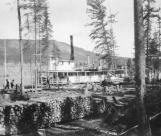14
A description of the S.S. Peace River leaving Peace River Crossing.August 1910
Peace River Crossing, Alberta, Canada
In the summer of 1910 a reporter for the Calgary Herald, Leroy Victor Kelly, boarded the S.S. Peace River at Peace River Crossing for a trip to Fort Vermilion. After waiting for the boat to return from taking on wood as fuel Kelly notes:
" At 2 o'clock the boat was back. A purser assigned us to our cabins, and there were white sheets on the berths. Everything was as trim and neat as a steamer on the Great Lakes, and the table manners were observed with great care, the passengers being allotted seats and tables, the captain taking the head and the purser the foot of the first table. There was a real service provided, cooking of a sort, and the course service was handled by a boy, who was better in many ways than the real waiters in some of the restaurants of the west.
As the boat pulled out, the citizens, and entire population of Peace River Crossing, gathered on the bank and gave us god-speed and good wishes. We responded with three cheers and a tiger. Three half-breeds with loaded rifles knelt on the bank and fired the royal salute, with riffle muzzles pointed skyward and the butts on the ground. Again we cheered and again the salute crackled out, then the steamer swung wide and took the big turn, and the current and the stern wheel paddles soon took us from the sight of the beautiful Peace River Crossing."
L.V. Kelly. North With Peace River Jim., edited by Hugh A. Dempsey. Historical Paper No. 2, Glenbow-Alberta Insitutute, Calgary, 1972, p.27.
Credits:L.V. Kelly. North With Peace River Jim., p. 27.
15
In addition to these written descriptions of travel on the S.S. Peace River considerable detail about the boat itself and its operations and landing spots can be found in a photo album dating to June and July 1913 kept by two passengers: Milton Martin and A. d'Aubigny.See:
University of Alberta Archives, Arthur Watts Fonds, 76-50
16
The S.S. Peace River docked at Hudson's Hope.June-July 1913
Hudson's Hope, British Columbia, Canada
 Credits:
Credits:University of Alberta Archives, Arthur Watts Fonds, UAA 76-50-14-202
17
The S.S. Peace River at a "Wood Pile" on the Peace River.June-July, 1913
Upriver from Fort St. John, British Columbia, Canada
 Credits:
Credits:University of Alberta Archives, Arthur Watts Fonds, UAA 76-50-14-163
18
The S.S. Peace River docked at the landing at Fort St. John, British Columbia.June-July 1913
Fort St. John, British Columbia
 Credits:
Credits:University of Alberta Archives, Arthur Watts Fonds, UAA 76-50-14-157
19
A group of passengers on the deck of the S.S. Peace River, 1913.June-July 1913
On the Peace River, Alberta, Canada
 Credits:
Credits:University of Alberta Archives, Arthur Watts Fonds, UAA 76-50-14-117
20
Passengers walking onto the deck of the S.S. Peace River.June-July 1913
Peace River Crossing, Alberta, Canada
 Credits:
Credits:University of Alberta Archives, Arthur Watts Fonds, UAA 76-50-14-108
21
John Sutherland, John Gullion and B. ManzerCirca 1906-1915
Peace River Crossing, Alberta, Canada
 Credits:
Credits:Peace River Museum, Archives & Mackenzie Centre, 82.1229.009
22
Captain John Gullion.Circa 1906-1915
Peace River Crossing, Alberta, Canada
 Credits:
Credits:Peace River Museum, Archives & Mackenzie Centre, 82.1229.008
23
In 1914 the decision was made to retire the S.S. Peace River and replace it with the S.S. Athabasca River, a boat with much larger freight capacity. The S.S. Peace River was retired in 1915.24
The S.S. D.A. Thomas (right) anchored next to the S.S. Peace River (left).circa 1916
Peace River Crossing, Alberta, Canada
 Credits:
Credits:Peace River Museum, Archives & Mackenzie Centre
25
The second component of the HBC "fleet" for the upper Peace River was the steam tug Messenger. This boat, made for the HBC in Kenora in 1897, was brought to Fort Vermilion in 1905 and operated from there as was the Peace River. The Messenger was to complement the Peace River and used primarily in the late summer and fall when water levels tended to be lower in the Peace River.26
The Messenger on the banks of the Peace River.1911
Fort Vermilion, Alberta, Canada
 Credits:
Credits:University of Alberta Archives, Hulbert Footner Fonds, UAA 77-147-87
27
One of the best descriptions of the operations of the Messanger can be found in New Rivers of the North, a travel book written in 1911 by Hulbert Footner, an author of mystery novels and travel literature. In the fall of 1911 Footner takes a 8 day journey from Fort Vermilion to Peace River Crossing with 12 other passengers on the Messenger. As the steam tug was the smallest steamboat to be used on the upper Peace River it was very crowded and there were no berths for passengers. Footner observes:"After all the good-byes [at Fort Vermilion] were said and the little boat poked her nose into the current, we made the alarming discovery that we were thirteen on board... . We expected to be seven days ascending the three hundred miles in the little steamboat." (pp. 225-6)
"Of these seven rainy days one was very like another. We steamed from daylight to dark, and at night we camped on the shore. Once a day in addition we went ashore to cut wood. There was not room enough for us and all our belongings on the little Messenger, so we towed a barge alongside that afforded us a little room to straighten in, when it was not raining two hard." (p. 229)
Footner had a large number of photogaphs taken during this trip and they can be found at:
University of Alberta Archives, Hulbert Footner Fonds, UAA 77-147.